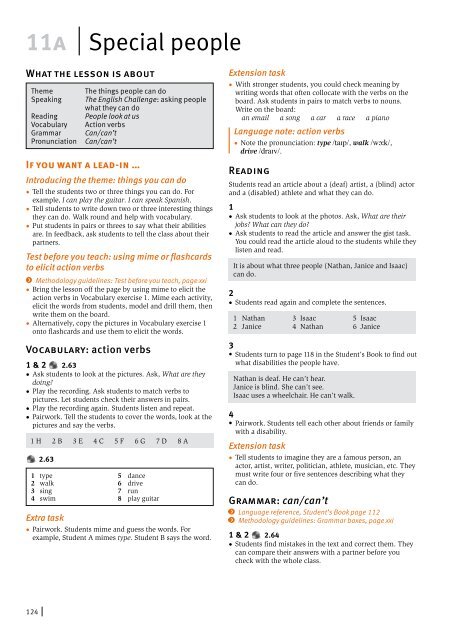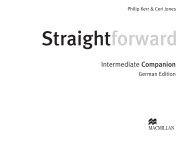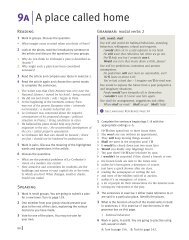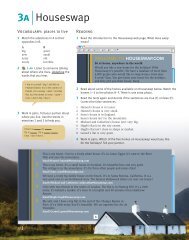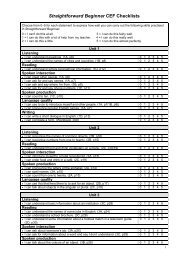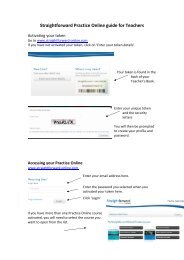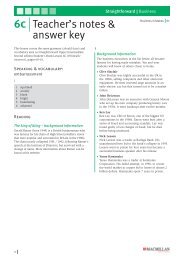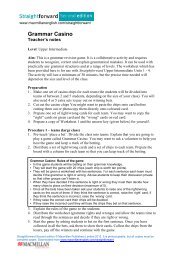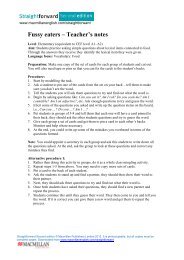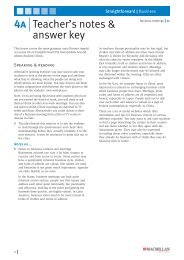Teacher's Book 0.24MB - Straightforward
Teacher's Book 0.24MB - Straightforward
Teacher's Book 0.24MB - Straightforward
- No tags were found...
You also want an ePaper? Increase the reach of your titles
YUMPU automatically turns print PDFs into web optimized ePapers that Google loves.
Special people 11a• Play the recording. Students listen and check.• In feedback, ask students to read out sentences. Ask whateach mistake is (see Language notes).Our son Charles was born with cerebral palsy. Charlesdon’t can can’t walk and he doesn’t can can’t run withthe other children. But he can do lots of other things. Hecans can read, he can write his name and he can to use acomputer. That’s not bad for a four-year-old.2.64Our son Charles was born with cerebral palsy. Charles can’twalk and he can’t run with the other children. But he cando lots of other things. He can read, he can write his nameand he can use a computer. That’s not bad for afour-year-old.Extra task• Get students to write six sentences, three saying what theycan do, three saying what they can’t do. They read themout to a partner.• Alternatively, ask students to write four can/can’tsentences. Tell them that three must be true and one nottrue. Put them in groups of four. Each student reads outtheir sentences. The rest of the group must guess whichone is incorrect.Language notes: can/can’t• Can and can’t are modal auxiliary verbs with manyuses. Here, they are used to talk about general ability.• Like most auxiliary verbs, can transposes to form thequestion (Can you …?) and is not followed by to. Thenegative is formed by adding ’t (an abbreviated not) tocan. It does not take s in the third person. Watch out forerrors such as, Do you can drive? I don’t can drive. I can’tto drive. He cans drive.• The form cannot may be used when writing formally.However, in general, when speaking or writing it is notused. Using cannot when speaking may soundover-emphatic.Teach a key word• Cerebral palsy is a disease in which a person’smovements become jerky and uncontrolled because ofbrain damage before or at birth.Pronunciation: can/can’t1 2.65• Play the recording. Students listen to the pronunciation ofcan in the sentences.2.65I can drive. I can’t drive. Can you drive?2 2.66• Play the recording. Students listen and write what theyhear.• Pairwork. Students practise saying the sentences.See audioscript.2.661 Can you swim?2 Yes, I can.3 No, I can’t.4 I can’t dance.5 I can dance.Language notes: can/can’t• The pronunciation of can is difficult. In questions andshort answers, can has its full value: Can /kæn/ you ski?Yes, I can /kæn/.• In the affirmative, can is unstressed. The main stressis on the main verb. So here can is pronounced with aschwa, I can /kən/ type.• Can’t has a long /aː/ vowel sound. Students may want tosimplify it to /æ/.• NB In American English can and can’t is generallypronounced /kæn/ and /kænt/.Speaking1• Ask the class, What can you do in English? Elicit anysuggestions from the students.• Students read the phrases and tick the ones they can do(hopefully, all of them).2 2.67• Play the recording. Students read and listen.2.67A: Can you spell your name in English?B: Yes, I can.A: Show me.B: M-I-C-H-A-E-L.3• Model the activity by asking students one or two Canyou …? questions. Then put students in pairs to play thegame. Monitor, prompt and correct.Extra task• Ask students to write down five other things they can doin English. Tell them to turn the sentences into Can you …?questions, then interview their partner.• Ask students to write down one thing they can do whichis special for them. For example, I can play the violin. I canspeak Italian. I can write computer programs. Walk roundand help students with vocabulary. At the same time, notedown the things they can do and write them on the boardin a list. For example, play the violin, speak Italian.• When students have all written one skill, point out thelist on the board. Students must stand up, walk round,and ask Can you …? questions until they find who cando what.If you want something extra …<strong>Straightforward</strong> Teacher’s Resource Discat the back of this book125
11b Special eventWhat the lesson is aboutTheme Glastonbury: a rock festivalSpeaking Phone dialogues: asking people whatthey are doingListening Phone dialogues: at a concertGrammar Present continuousPronunciation /ŋ/English International organizationsaround youIf you want a lead-in …Introducing the theme: rock festivals• Write rock festivals on the board. Ask students to tell youthe names of famous rock festivals in their country. Ask,What bands play there? When is it? What other things canyou do there? What is good about it?• Write the following words on the board: rock bands,camping, summer, thousands of people, concert, music,outside. Ask students, What is the topic of the unit? Whatis the connection between the words and the topic?Test before you teach: present continuousMethodology guidelines: Test before you teach, page xxi• Write the names of three members of your family orfriends on the board, for example, Paul, Carole, Steve. Tellstudents that you know these people and that they canask you questions to find out about these people. Studentsmay ask anything, but they are likely to ask Who is Paul?(He’s my brother) and Where is he? (use the presentcontinuous in your answer: At the moment, he’s sitting inan office in London).• Pairwork. Students write three names, then ask questionsto find out who the people are and what they are doing.Speaking1• Ask students to look at the photos. Ask the questions inthe Student’s <strong>Book</strong>.Extra discussion task• Ask more questions: What do people do at festivals? Whydo people go to festivals? Are there a lot of festivals in yourcountry? Which are the best ones? What makes a perfectfestival?ListeningStudents listen to four short telephone dialogues in whichpeople at the Glastonbury Festival say what they are doing.1 2.68• As a lead-in, ask students, Why do people at a festivaluse a mobile phone? Elicit lots of reasons, for example,to contact friends who are lost in the crowd, to arrange tomeet people at a concert, to text or tell friends and familywhere they are, to take photos or video clips of bands, torecord some of the music.126• Play the recording. Students listen and match thedialogues to their topics.a 2 c 3b 4 d 12.68Dialogue 1 M=man W=womanM: Hello?W: Hi! Where are you?M: I’m in the car. I can’t talk now, though, I’m driving.W: I’m at the front gates. I have the tickets.M: OK. See you, bye!Dialogue 2 W=woman J=JoshW: Josh?J: Hello?W: Josh, what are you doing? We’re waiting for you!J: I’m getting something to eat.W: What? I can’t hear a thing.J: I’m eating! I’ll be there in a minute.Dialogue 3 R=Rob Mi=MichelleR: Michelle?Mi: Rob? Where are you? I can’t see you.R: I’m standing over here, near the stage. I can see you!Over here!Mi: Where?R: I’m wearing my red jacket! You’re looking at me now!Mi: Oh yes, there you are! OK, I’m coming over now.Dialogue 4 W=woman M=manW: Hello?M: Hi. Are you at the office?W: No, I’m not working today. I’m at Glastonbury.M: Glastonbury? How is it? Is it raining?W: Yes, it is. As usual. But we’re having a good timeanyway.M: Oh. Well, call me tonight, OK?W: Sure.2 2.68• Play the recording again. Students listen and choose thecorrect phrase. Let them check their answers in pairs.1 b 2 a 3 b 4 aLanguage note: listening• There is an interesting area of related vocabulary herewhich you may want to introduce to students. Thefollowing words are in the dialogues in this lesson:concert tickets stage have a good timeCultural notes: listening• The first Glastonbury Festival was held near the town ofGlastonbury (in south-west England) in September 1970.It lasted two days and featured Marc Bolan and otherartists of the time. 1,500 people came and it only cost £1to enter. In 1971 the festival moved to June, the time ofthe Summer Solstice, and was known as the GlastonburyFayre. A pyramid-shaped stage was constructed on a siteabove the Glastonbury-Stonehenge ley line and this hasbecome one of the symbols of the Glastonbury Festival.• Since then Glastonbury has grown and grown. It isnow officially known as the Glastonbury Festival forContemporary Performing Arts and is huge. By June
Special event 11b2005, it was a five-day festival and the site had grownto incorporate two major stages, a dance village witheight different venues and numerous other attractions,including a circus. In June 2011, 135,000 peopleattended, paying £195 each for a ticket.• During its history, the festival has supported manycauses, such as CND (the Campaign for NuclearDisarmament), Greenpeace and the Make PovertyHistory campaign.• The headline acts in 2011 were U2, Coldplay andBeyoncé.Grammar: present continuousLanguage reference, Student’s <strong>Book</strong> page 112Methodology guidelines: Grammar boxes, page xxi1 2.69• Play the recording. Students listen and write sentences.See audioscript below.• Tell them to listen first and put numbers next to each verbin the box (to show the order). Then tell them to write. Letstudents check their answers in pairs.2.69Sound effects1 He is talking on the phone.2 They are playing guitar.3 She is having a shower.4 They are driving.5 She is typing.2 & 3 2.70• Ask students to read the dialogue quickly. Ask, Where arethe speakers?• Students complete the dialogue. Do the first as anexample. Let students check their answers in pairs.• Play the recording. Students listen and check theiranswers.See audioscript below. The answers have beenunderlined.2.70A: Hello?B: Hello, darling, it’s your mother. How are you?A: Fine, thanks.B: What are you doing? What’s that noise?A: I’m at a concert. The band’s playing. People are dancingand … it’s a bit crazy.B: Oh, that sounds nice. When does the concert finish?A: What?B: Darling, you’re not listening.A: I am listening, Mum, but I can’t hear you! John andLiz are talking at the same time … Quiet, I’m using thephone …B: Hello? Hello? Oh dear, his phone’s not working now.Extra task• Pairwork. Students practise reading the dialogue.Language notes: present continuous• English uses the present continuous to talk aboutevents happening now or around now. It is used withactive verbs (run, play, etc) not stative verbs (be,understand, etc).• In terms of form, students need to manipulate theauxiliary verb to be correctly. They need to be awarethat am, is and are contract to I’m, he’s, we’re, etc. Theymust also remember the form rules when changingthe infinitive to the -ing form (the present participle).Compare the following:do + ing doingstudy + ing studyinglive – e + ing livingrun + n* +ing running(*ie consonant is doubled when a verb ends witha consonant)• Be aware that in some languages the present simpleform is used in this context. If you have a monolingualclass, it is useful to think about how similar the useof the present continuous in the students’ L1 is tothe use in English. If it’s the same, the tense will bestraightforward. If not, students will need lots ofcontextualized practice to get the hang of it.Pronunciation: /ŋ/1 2.71• Play the recording. Students listen and repeat the soundand words.2.71/ŋ/havingthingeating2• Ask students to underline the sounds, then check with apartner. Tell the pairs to practise saying the sentences.1 I’m going to the bank. 4 Is English a difficult2 She’s speaking French. language?3 I can’t think.Extension task• Ask students to tell you as many sports and hobbies asthey can think of which end with -ing. Write them onthe board. Correct any mispronunciations of /ŋ/ beforeaccepting the word.• To make this competitive, divide the class into two teams.Each team takes it in turns to name a sport or hobby untilone team can’t think of another word and loses.• Here is a list: swimming, running, jogging, skiing,waterskiing, sailing, surfing, windsurfing, snowboarding,climbing, boxing, wrestling, diving, skydiving, fishing,bowling, playing football/rugby/cricket/tennis/golf/hockey/basketball/baseball/volleyball.Language notes: /ŋ/• /ŋ/ is a velar nasal sound. It is produced by slightlyblocking the airstream by raising the tongue so that ittouches the velum (the fleshy part of the roof of themouth behind the alveolar ridge or ridge of the mouth).In blocking the airstream, some air is forced throughthe nose.• You can show students how to make this sound withyour hands. Hold both hands face down in front of thestudents with the bottom hand slightly back from the tophand – move the bottom hand up to touch the middle of127
11b Special event128the top hand, thus showing how the tongue touches thevelum. See the diagram below.• Students tend to want to attempt to pronounce the gat the end of these words, approximating it to a hard,voiced /g/ sound or unvoiced /k/ sound. Others mayapproximate /ŋ/ to /n/.Speaking1 2.72• Ask students to look at the pictures. Ask, What can yousee? What are they doing? What are they saying?• Play the recording. Students listen and match the dialogueto the correct picture.1 B2.72A: Hi, how are you?B: I’m fine.A: Can you talk right now?B: Yes, I can.A: What are you doing?B: I’m at home. I’m watching TV.Extra task• Ask students to listen and repeat the dialogue, payingattention to the intonation.• Alternatively, you could model and drill the dialogueyourself, then put students in pairs to practise saying it.2 & 3• Pairwork. Tell students to choose a picture and write ashort dialogue. Monitor, prompt and correct.• When students are happy with their dialogue, ask themto practise it a few times. Then ask a few pairs to stand upand act out the dialogue for the class. The rest of the classmust guess which picture they chose.Extra task• Play Three-Line Dialogues. Go through some oldmagazines and cut out any pictures you find showing twopeople talking. It doesn’t matter what the situation is.Hand out the pictures so that each pair in the class has atleast one.• Model a three-line dialogue. Here are three examples:Hi. How are you?Fine. And you?Fine, thanks.Hi. What are you doing?Nothing.Really?Hi. Are you doing your homework?No. I’m writing a letter.Who to?• Each pair must then improvise one or two three-linedialogues from their picture. After a minute, tell studentsto pass the picture to the next pair in a clockwisedirection. Students improvise from the next picture and soon until students run out of energy. You could ask studentsto act out a few of the more interesting dialogues youheard in the class.English around you: internationalorganizations1, 2 & 3 2.73• Ask students to look at the pictures. Play the recording.Ask, Which organisations do you know? What are they inyour language?• Ask students to name other international organizations.2.73Fairtrade foundationInternational Committee of the Red CrossGreenpeaceSave the ChildrenExtra discussion task• Ask, Which causes are important to you? Do you givemoney? Who to? Do you help a charity or NGO? What doyou do? Do you think it is good or bad that famous peoplehelp international organizations? Why?Cultural notes: international organizations• Greenpeace is an organization that campaigns onecological issues. Famously, the Greenpeace ship, theRainbow Warrior, challenges nuclear vessels, whalingships, oil tankers, etc that cause ecological damage onthe high seas.• Fairtrade is an organization that campaigns for fairtrade between rich countries and poor countries. Itproduces its own brand of foodstuffs (Fairtrade coffee,for example) in which the product has been purchased‘fairly’ from farmers in developing countries.• Red Cross is an organization which goes to disasterareas to help victims of war and natural disasters.• Save the Children is an organization that campaigns onbehalf of children in poverty.• Other British organizations: Oxfam (campaignsfor famine relief); RSPCA (Royal Society for thePrevention of Cruelty to Animals); Friends of theEarth (environmental organization); Age UK (helpselderly people); WWF (World Wildlife Fund to protectendangered species); Crisis Now (disaster relief);WaterAid (helps world poverty by providing access towater).<strong>Straightforward</strong> Beginners TB1405010533_pg128_11Ba.epsb/w digital artworkby Kathy BaxendaleWeb research taskMethodology guidelines: Web research tasks, page xxiFestivals• Ask students to research a famous festival in theircountry or abroad. They could find out about thefollowing (British-based) festivals: Reading Festival,Leeds Festival, WOMAD, V, Cropredy Festival.• Students must find the following information: Where isthe festival? When is it and how long does it last? Howmuch is it? What bands play? What sort of music does ithave? What other things can you do at the festival?Web search key words• festivals/music/informationIf you want something extra …<strong>Straightforward</strong> Teacher’s Resource Discat the back of this book
11cSpecial paintingsWhat the lesson is aboutThemeSpeakingSpeaking &readingListeningFunctionallanguageFavourite paintingsDescribing a favourite paintingSpecial paintingsMonologues: three people eachdescribe a different paintingTalking about a paintingIf you want a lead-in …Introducing the theme: favourite paintings• If you feel your students might be interested in andknowledgeable about art, personalize the Lead-in byasking, What is your favourite painting? Elicit a fewsuggestions. You could brainstorm a few paintings andartists to prompt students who can’t think of a favourite.• Tell students to close their eyes and think of the painting.Say, Think about how to describe it and what you likeabout it. Put students in pairs to tell each other about theirfavourite painting.Test before you teach: describing a pictureMethodology guidelines: Test before you teach, page xxi• Draw a simple landscape scene on a large piece of paper(or on the board before students arrive for your lesson).(For example, draw some mountains in the background ofyour picture, a lake in the foreground with a boat on it. Apath or road going past the lake with a car on it. A houseby the road with people walking past it. A plane flyingover the mountains.)• Tell students to look at the picture and think about howto describe it. You could pre-teach any key vocabulary.Ask students to say what is happening in the picture.Encourage There is/are … and the present continuous.• You could write the following words on the board to helpstudents be more accurate when describing the pictures:on the left on the right in the middleat the top/bottomPre-teach key words: art• Write Art on the board and brainstorm words around thetopic. Use mime to elicit and check the words. Try to elicit:artist, painting, picture, art gallery, paint, draw, pencil.Speaking & reading1 & 2• Ask students to look at the paintings in pairs and discussthe questions. In feedback, ask, Which of these is yourfavourite painting? Why? What sort of painting or art doyou like? How often do you go to art galleries?• Ask students to read the article and say what theconnection is between the paintings.They were in a competition to find Britain’s favouritepainting.3• Ask students to read the article again and answer thequestions. Let students compare their answers in pairs.1 Britain’s favourite paintings.2 2005.3 To make people talk and think more about art.4 More than 118,000.4• In pairs, students discuss the questions. In feedback, findout which piece of art is most popular in the class.Language note: speaking & reading• There is an interesting set of vocabulary here around thetopic of art. (See Pre-teach key words: art in the Lead-insection for suggested words to pre-teach.)Cultural notes: speaking & reading• On 25th July 2005 a poll was launched by the BBC’sRadio 4 Today show, in partnership with the NationalGallery, to find Britain’s favourite painting. The top tenshortlisted paintings covered five centuries of Europeanart from 1434 to 1971.• In date order, the following is the shortlist of the tenpaintings selected from Britain’s art galleries:The Arnolfini Portrait – Jan van Eyck (The NationalGallery, London)The Baptism of Christ – Piero della Francesca (TheNational Gallery, London)A Rake’s Progress – William Hogarth (Sir John Soane’sMuseum, London)Revd Dr Robert Walker Skating on Duddingston Loch –Sir Henry Raeburn (National Galleries of Scotland)The Hay Wain – John Constable (The National Gallery,London)The Fighting Temeraire – JMW Turner (The NationalGallery, London)The Last of England – Ford Madox Brown (BirminghamMuseums and Art Gallery/The Fitzwilliam Museum,Cambridge)A Bar at the Folies-Bergère – Edouard Manet (CourtauldInstitute Gallery, London)Sunflowers – Vincent Van Gogh (The National Gallery,London)Mr and Mrs Clark and Percy – David Hockney (TateBritain)129
11c Special paintings• Joseph Mallord William (JMW) Turner (1775–1851) isan English Romantic artist, who painted landscapes andseascapes. He was born in London and was educatedat the Royal Academy Schools. Turner painted in a free,expressive way and tried to capture light, colour andmovement. He was very interested in technology, whichis why he painted sailing ships such as The FightingTemeraire and trains, which he famously painted inRain, Steam and Speed.• Edouard Manet (1832–1883) was an Impressionistpainter who was born in Paris. He was interested inthe contrast between light and shadow, and he tendedto paint from a model. Many of his works showed lifein Paris and were quite shocking in his day. In A Barat the Folies-Bergère we see a bar girl who stares at theobserver, looking bored, lonely and unhappy. In thereflection of the mirror we see the audience at theFolies-Bergère, a variety club in late 19 th -century Paris.• Vincent Van Gogh (1853–1890) was aPost-Impressionist painter. Although he is one of today’smost popular artists, this was not the case when hewas still alive. His works are characterized by a veryexpressive use of brilliant colour. He was born in theNetherlands and lived in Antwerp, Paris and Arles inProvence, where he painted his now famous series ofSunflowers. The painting in the National Gallery is oneof four paintings of sunflowers dating from August andSeptember 1888, which Van Gogh painted for his friendGauguin. In 1890, suffering from depression, Van Goghshot and killed himself.ListeningStudents listen to monologues in which three people eachdescribe a different painting.1 2.74• Ask students to look at the paintings on page 100 of theStudent’s <strong>Book</strong>. Say, You are an art critic on the radio. Howcan you describe the paintings? Elicit descriptions of thepaintings from the students. Encourage there is/are andthe present continuous.• Play the recording. Students listen and put the paintings inthe order they hear them. Let students check their answersin pairs.1 Sunflowers2 A Bar at the Folies-Bergère3 The Fighting Temeraire2.74This painting is one of the most popular in Britain. VincentVan Gogh painted these flowers when he was in France.The flowers are yellow, a symbol of happiness. Van Goghpainted more than eleven paintings with sunflowers.In this painting I can see a woman. She is working in abar in Paris. The amazing thing about this painting is thewoman’s eyes. I can’t say how she is feeling. Maybe she’ssad. Maybe she doesn’t want to work there. There are lotsof people behind her. They are drinking and having a goodtime.2 2.74• Give students a moment to read the sentences, then playthe recording again. Students listen and decide if thesentences are true or false. Let them check in pairs.1 F (This painting is one of the most popular in Britain.)2 T3 T4 T5 T6 F (The Temeraire is the big boat.)Extra task• Ask students to look at the paintings in pairs. Ask them todescribe the paintings using phrases they remember fromthe listening.Functional language: talking about apainting1 & 2 2.75• Ask students to read the sentences and match them to thepaintings. Let students check their answers in pairs.• Play the recording. Students listen, check and repeat.1 A Bar at the Folies-Bergère2 Sunflowers3 The Fighting Temeraire2.751 In this painting I can see a woman at a bar.2 The flowers are yellow.3 There are two boats on the river.3• Ask students to make other sentences about the paintings.Describe the first painting briefly yourself to give studentsthe idea. You could put the following prompts on theboard to help them.There is/are …You can see …I think …Maybe …Speaking1 & 2• Ask students to look at the painting on page 101 of theStudent’s <strong>Book</strong>. Ask, Do you know the painting? Do youknow anything about Edward Hopper? What can you see inthe picture? Do you like it? What’s good about it? How doesit make you feel?• Give students three or four minutes to make notes inanswer to the questions. Monitor and help with vocabularyand ideas.• Pairwork. Students talk about the painting.The Temeraire was a famous warship in English history.In this painting we can see a small boat in front of TheTemeraire. The small boat is pulling the big boat. Thecolour of the sun and the sea is very dramatic here.I really like this painting.130
Special paintings 11cExtra task• Find and bring in a few magazine pictures of famouspaintings. Put students in groups. Give each group apainting. Tell each group to prepare a short description oftheir painting.• Once students have prepared and written their pieceon the painting, tell them to stick the painting and itsdescription on the classroom wall. Ask one student ineach group to stay with their painting. Tell the rest ofthe class to circulate. They look at the paintings, readthe descriptions and ask the person stationed with thepainting any questions they can think of.• Alternatively, stick the paintings and descriptions ondifferent walls. Students must circulate and matchpaintings to descriptions.Web research taskMethodology guidelines: Web research tasks, page xiiiFamous paintings• Ask students to research their favourite famous paintingon the web.• They must find out when it was painted, and interestingdetails about the artist and the painting.• They present their findings to the class.Web search key words• name of painting or artist/information/biographyIf you want something extra …<strong>Straightforward</strong> Teacher’s Resource Discat the back of this bookExtension task• If you haven’t already done so, play the describing apicture or picture dictation activity detailed in the Testbefore you teach: describing a picture section of theLead-in.• Alternatively, play picture dictation using the picture fromthe Test before you teach: describing a picture sectionof the Lead-in, but this time ask one student to come tothe board and give him/her a board marker. Hold up thepicture. Tell the rest of the class to describe the picture.The student at the board must draw it.Cultural note: Edward Hopper• Automat shows a lone woman staring into a cup ofcoffee. It is often seen as an image of urban alienation –the woman seems melancholy, downcast, introspectiveand alone. However, as with many of Hopper’spaintings, it is also ambiguous. It is not clear why she isthere. She is well-dressed and attractive, so why is sheso sad?• Edward Hopper (1882–1967) was a realist painter fromNew York who produced oil paintings showing people inurban scenes. His paintings are often fatalistic, showingpeople in lonely, introspective situations. His mostfamous painting is Nighthawks (1942).• Automats were popular in the US in the early 20 thcentury. They were fast food restaurants in which foodand drink was purchased from vending machines.131
11d ReviewWhat the lesson is aboutThemeSpeakingListeningGrammar &VocabularyFunctionallanguageReviewDescribing paintingsA job interview (talking about abilities)Present continuous; Can/can’t; ActiveverbsTalking about a painting (I think …,Maybe …, I can see …, There is/are …)If you want a lead-in …Introducing the theme: review• Find a magazine picture of a well-known person (an actor,pop star, politician, etc). (Find a picture in which he or sheis doing something.) Put the picture on the board. Ask,Who is he/she? What can you tell me about him/her?• Write the following on the board:one thing he or she is doingtwo things he or she can doone thing he or she can’t doone other thing you can see in the picture• Give students a minute to think of things to say. Then putthem in pairs to discuss.ListeningIn this listening, students hear a man being given a jobinterview by a woman. She asks about his abilities, but itturns out that he’s in the wrong job interview.1 2.76• Ask students to look at the photo. Ask, Where are they?Who are they? What are they doing? What are they saying?• Play the recording. Students listen and answer the gistquestion.The man is in the wrong room for his interview.2.76M=man W=womanM: Hello. Good morning.W: Good morning.M: I’m here for the job interview.W: Ah yes, yes. The job interview. Of course, come in.M: Thanks.W: Right. OK. I have some questions for you.M: Fine.W: Can you sing?M: Sorry?W: Sing … sing, you know la la la.M: Err … No, I can’t. Not very well, no.W: Oh. Can you dance?M: What? Just a minute …W: Answer the question, please, yes or no. Can you dance?M: No, I can’t.W: You can’t dance and you can’t sing. What are you doinghere?M: I’m here for the tourist information job.W: Tourist information job? Oh, no. That job interview is inroom 4. This is room 3. This room is for television actorinterviews.M: Ah, sorry.W: That’s OK. Goodbye, then.M: Goodbye.2 2.76• Play the recording again. Students listen and tick thecorrect sentences. Let them check their answers in pairs.1 b 2 a 3 a 4 aExtension task for stronger classes• Ask students to find audioscript 2.76 on page 125 of theStudent’s <strong>Book</strong>. Tell them to practise the dialogue in pairs.• Write a list of jobs on the board: athlete, actor, pop star,footballer, etc. Put students in pairs. Student A is a jobinterviewer. Tell him/her to choose a job and think of Canyou …? questions to ask. Student B is coming for a jobinterview. Tell him/her to choose a job they like and thinkof things they can do to do that job.• When students are ready, tell them to roleplay theinterview. At the end, find out if they chose the same job.Grammar & vocabularyLanguage reference, Student’s <strong>Book</strong> page 112Methodology guidelines: Grammar boxes, page xxi1• Students make sentences. Ask them to look at theexamples. Let students check their answers in pairs.3 The woman isn’t listening to music.4 They are talking.5 The woman isn’t looking for a job.6 The man is looking for a job.7 They aren’t having lunch.8 They are having a job interview.2• Ask students to look at the pictures. Ask, What can yousee? Elicit key vocabulary.• Students complete the sentences. Do the first as anexample. Let students check their answers in pairs.1 can’t dance 4 can’t play2 can run 5 Can; see3 can’t drive3 & 4• Pairwork. Students cover the sentences and try toremember them from the picture prompts.• Give students two minutes to ask their partner Can you …?questions. They must find out as many things as they canthat they have in common (or not).• Students then complete the sentences in the Student’s<strong>Book</strong> to report their findings. Ask a few pairs to tell theclass what they found.132
Review 11dExtension task• Write on the board: Can you …?/Yes, I can./No, I can’t./Ican … but I can’t … Tell students in pairs to write adialogue using the phrases on the board. They can use thephrases as many times as they like.• Ask a few pairs to read out their dialogues for the class.Methodology Builder (20)A few more hintsThis section gathers together a few hints about teachingbeginners that haven’t been mentioned so far.Who asks the questions?When researchers observe language teaching classes (oralmost any classes, actually!) they often comment thatthe teacher is the person who asks all the questions. Isuppose this is understandable as a teacher naturallyhas to ask a lot of questions. However, students alsoneed to get practice in making questions, so make apoint sometimes of turning this habit around. Find waysto get students asking questions to each other or to you.Teach real EnglishWherever possible teach real English, ie English thatmight realistically be used in the world outside. Thatmay sound obvious, but it’s an important point, andone that is surprisingly easy to forget. There is one waythat teachers often unwittingly fall foul of this guidelinewhen they ask their students to give a full sentence intheir answer. Why is this a problem? Well, let’s thinkabout some language in lesson 5C. The interviewer asksLord Duncan Do you have more than one office? andLord Duncan replies Yes, I do. This is a normal Englishreply. Make sure that when you practise sentences likethis with students that you don’t ask them to make fullsentences. In reply to Do you have more than one office?it would sound very odd to say Yes, I have more thanone office. In any normal dialogue no one in real lifewould speak like this. Short answers are very commonin English, and most of the time we don’t unnecessarilyrepeat things that have already been said in thequestion.Keep an eye on demand levelsBeing a beginner is a very exhausting thing. Studentscan suddenly panic or switch off just because they aretired or their brain is full! When planning your class, tryto make sure that you keep an eye on balancinghigh-demand and low-demand activities.• High-demand refers to things that are reallychallenging for students, forcing them to think andremember things. High-demand involves quite a lot ofbrain-stretching struggle!• Low-demand refers to things that are more relaxingto do. They are more fun than effort and can be donewithout a lot of struggle.So, if you have just taken your students through a highdemandactivity, bear in mind that they might need alow-demand one afterwards. And if the students havemainly being doing light, entertaining tasks, they areprobably ready for a high-demand one.Keeping recordsIt will probably pay to spend a little time talking withstudents about how best to manage their learning.Students may be bringing some poor learning habitswith them from previous courses. Perhaps the mostimportant area worth spending a little time on isencouraging students to think about how they keeprecords of new vocabulary and grammar that they study.Without talking this through most students tend tocollect a random higgledy-piggledy mess of notes, uselessfor revision or review purposes and probably neverlooked at again after they write them. Instead, encouragestudents to keep an exercise book just for notes aboutgrammar and vocabulary (a loose leaf file is even better)and allow some time in class for students to write downtheir notes (rather than having them scribble at the sametime as you are teaching).• Talk through alternatives to the traditional, butrelatively useless lists of random words withtranslations.• Encourage students to think about recording otheruseful information such as word stress.• Get students to think about grouping related itemstogether on single pages devoted to a topic.• Show students mind maps and encourage them to givethem a go. These visual records can be so useful forhelping with memorization and revision.Functional language1, 2 & 3• Students rearrange words to make sentences. Do the firstas an example. Let students check their answers in pairs.1 I think it’s a Van Gogh painting.2 There are four men in this photo.3 I think it’s in France.4 The men are sleeping.5 In this painting I can see a café.6 Maybe this is in New York.• Pairwork. Students match sentences to pictures andpractise saying the sentences.1 A 2 B 3 A 4 B 5 A 6 B• Ask students to discuss the questions with a partner.133
11d ReviewExtra task• Pairwork. Student A reads out the sentences in exercise1 and Student B points to the picture described. StudentA can then improvise more sentences to describe thepictures. Student B must listen and point to the picturedescribed. Students then swap roles.SpeakingCommunication activities: Student's <strong>Book</strong> pages114 & 1191• Pairwork. Student A turns to the picture on page 114 ofthe Student’s <strong>Book</strong>. Student B turns to the picture on page119. Students must describe their pictures and find threedifferences. You could prompt the students by eliciting andreminding them of the language required here: I/You cansee …, There is/are …, … is/are … -ing …DifferencesIn Student A’s picture the man in the sunglasses is eatinga sandwich. In Student B’s picture he is drinking.In Student A’s picture the people are sitting down. InStudent B’s picture they are standing up and dancing.In Student A’s picture the poster is green and yellow. InStudent B’s picture, it is green and red.In Student A’s picture the band is ‘The Lemons’. InStudent B’s picture the band is ‘The Apples’.Self-assessment• Ask students to tick what they can do.Review game• Play a mime game. Divide the class into two groups,Group A and Group B. Tell each group to write a list of tenactivities (using -ing) in a list on a piece of paper. Givethem examples. For example, they could choose sportslike swimming or skiing, or everyday activities like eatingchocolate or doing homework.• Once students have written their list, collect the list fromeach group and check them briefly for errors. Hand GroupA’s list to two people in Group B. Tell them to keep it secretfrom the rest of the group. Hand Group B’s list to twostudents in Group A. Tell the students with the lists thatthey must mime each activity on the list. The rest of thegroup must shout out as soon as they guess the activity.The aim is for your group to guess all ten activities beforethe other group finishes.• If it’s popular, you could always play the game againwith different lists and different students acting out theactivities.If you want something extra …<strong>Straightforward</strong> Teacher’s Resource Discat the back of this book134


